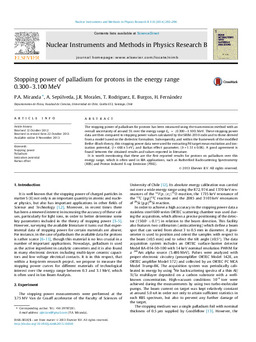| dc.contributor.author | Miranda, P. A. | |
| dc.contributor.author | Sepúlveda, A. | |
| dc.contributor.author | Morales, J.R. | |
| dc.contributor.author | Burgos, E. | |
| dc.contributor.author | Fernández, H. | |
| dc.contributor.author | Rodríguez Cabello, Tabatha Pamela | |
| dc.date.accessioned | 2022-07-13T20:13:54Z | |
| dc.date.issued | 2013 | |
| dc.identifier.uri | http://hdl.handle.net/11086/27271 | |
| dc.description.abstract | The stopping power of palladium for protons has been measured using the transmission method with an overall uncertainty of around 5% over the energy range Ep=(0.300–3.100) MeV. These stopping power data are then compared to stopping power values calculated by the SRIM-2010 code and to those derived from a model based on the dielectric formalism. Subsequently, and within the framework of the modified Bethe–Bloch theory, this stopping power data were used for extracting Pd target mean excitation and ionization potential, (I = 468 ± 5 eV), and Barkas effect parameter, (b = 1.51 ± 0.06). A good agreement is found between the obtained results and values reported in literature. It is worth mentioning that these are the first reported results for protons on palladium over this energy range, which is often used in IBA applications, such as Rutherford Backscattering Spectrometry (RBS) and Proton Induced X-ray Emission (PIXE). | en |
| dc.description.uri | http://dx.doi.org/10.1016/j.nimb.2013.10.020 | |
| dc.format.medium | Electrónico y/o Digital | |
| dc.language.iso | eng | es |
| dc.rights | Attribution-NonCommercial-NoDerivatives 4.0 International | * |
| dc.rights | restrictedAccess | |
| dc.rights.uri | http://creativecommons.org/licenses/by-nc-nd/4.0/ | * |
| dc.source | 0168-583X | |
| dc.subject | Stopping power | en |
| dc.subject | Palladium | en |
| dc.subject | Ionization potential | en |
| dc.subject | Barkas effec | en |
| dc.title | Stopping power of palladium for protons in the energy range 0.300-3.100 MeV | en |
| dc.type | article | es |
| dc.description.version | publishedVersion | es |
| dc.description.fil | Fil: Rodríguez Cabello, Tabatha Pamela. Universidad Nacional de Córdoba. Facultad de Matemática, Astronomía y Física; Argentina. | es |
| dc.description.fil | Fil: Rodríguez Cabello, Tabatha Pamela. Universidad de Chile; Chile | es |
| dc.description.fil | Fil: Miranda, P. A.. Universidad de Chile; Chile | es |
| dc.description.fil | Fil: Sepúlveda, A. Universidad de Chile; Chile | es |
| dc.description.fil | Fil: Morales, J.R. Universidad de Chile; Chile | es |
| dc.description.fil | Fil: Burgos, E. Universidad de Chile; Chile | es |
| dc.description.fil | Fil: Fernández, H. Universidad de Chile; Chile | es |
| dc.journal.city | Amsterdam | es |
| dc.journal.country | Países Bajos | es |
| dc.journal.editorial | Elsevier B.V. | es |
| dc.journal.pagination | 292-296 | es |
| dc.journal.title | Nuclear Instruments and Methods in Physics Research B | es |
| dc.journal.volume | 318 | es |
| dc.description.field | Física Atómica, Molecular y Química (física de átomos y moléculas incluyendo colisión, interacción con radiación, resonancia magnética, Moessbauer Efecto.) | |
| dc.identifier.url | http://dx.doi.org/10.1016/j.nimb.2013.10.020 | |
| dc.identifier.doi | http://dx.doi.org/10.1016/j.nimb.2013.10.020 | |





